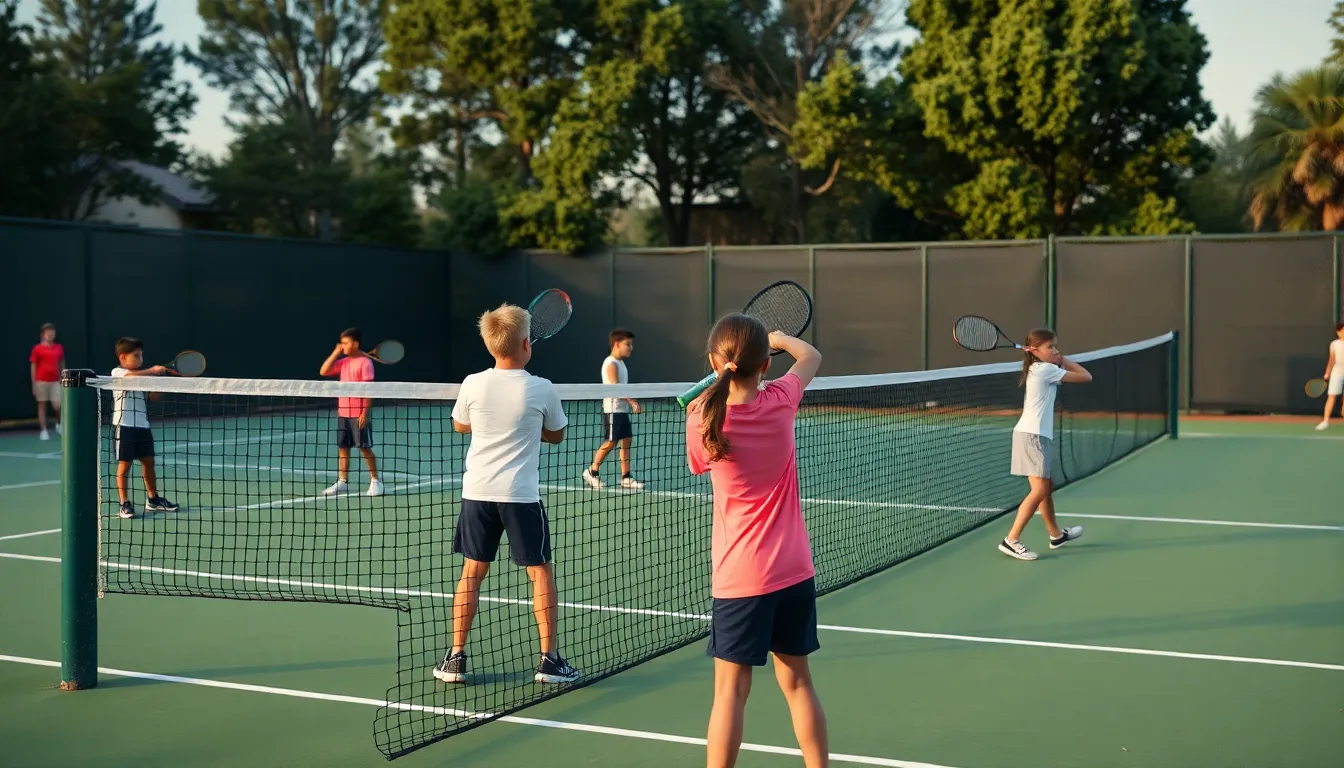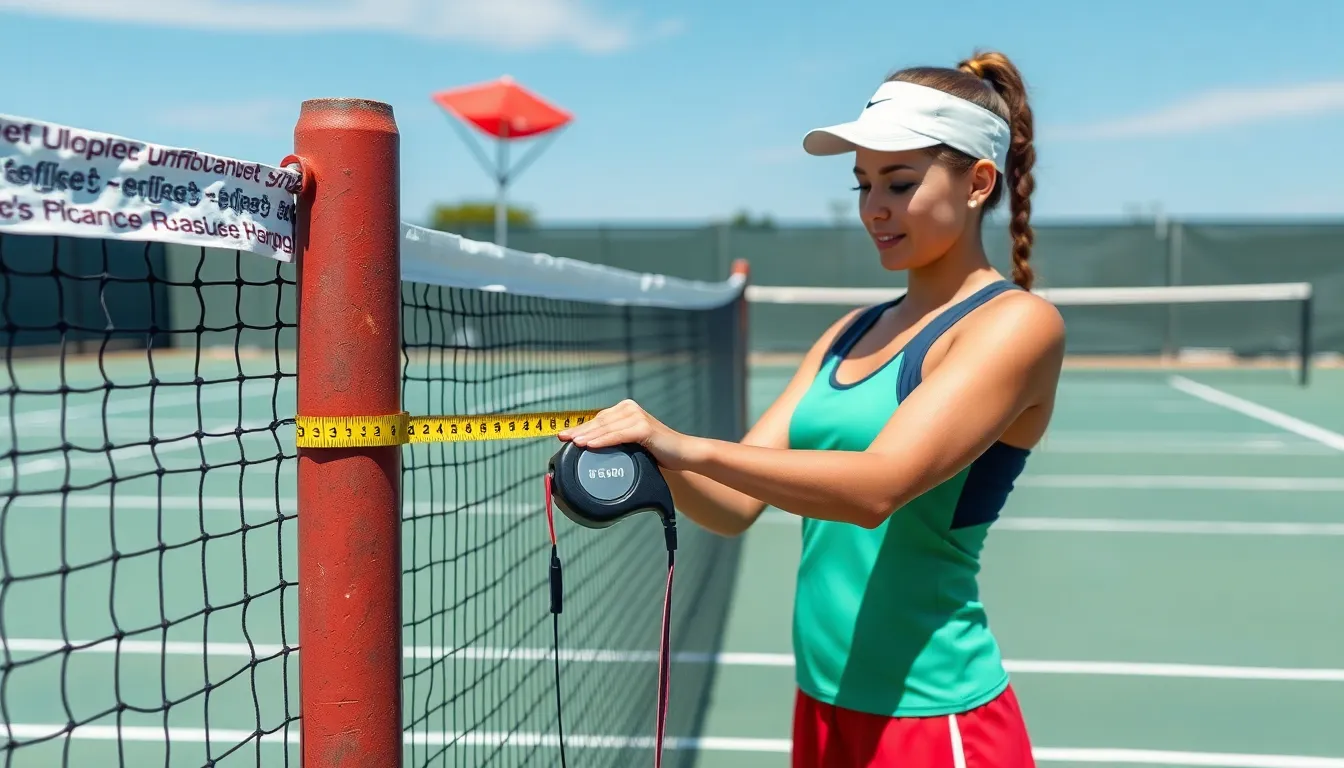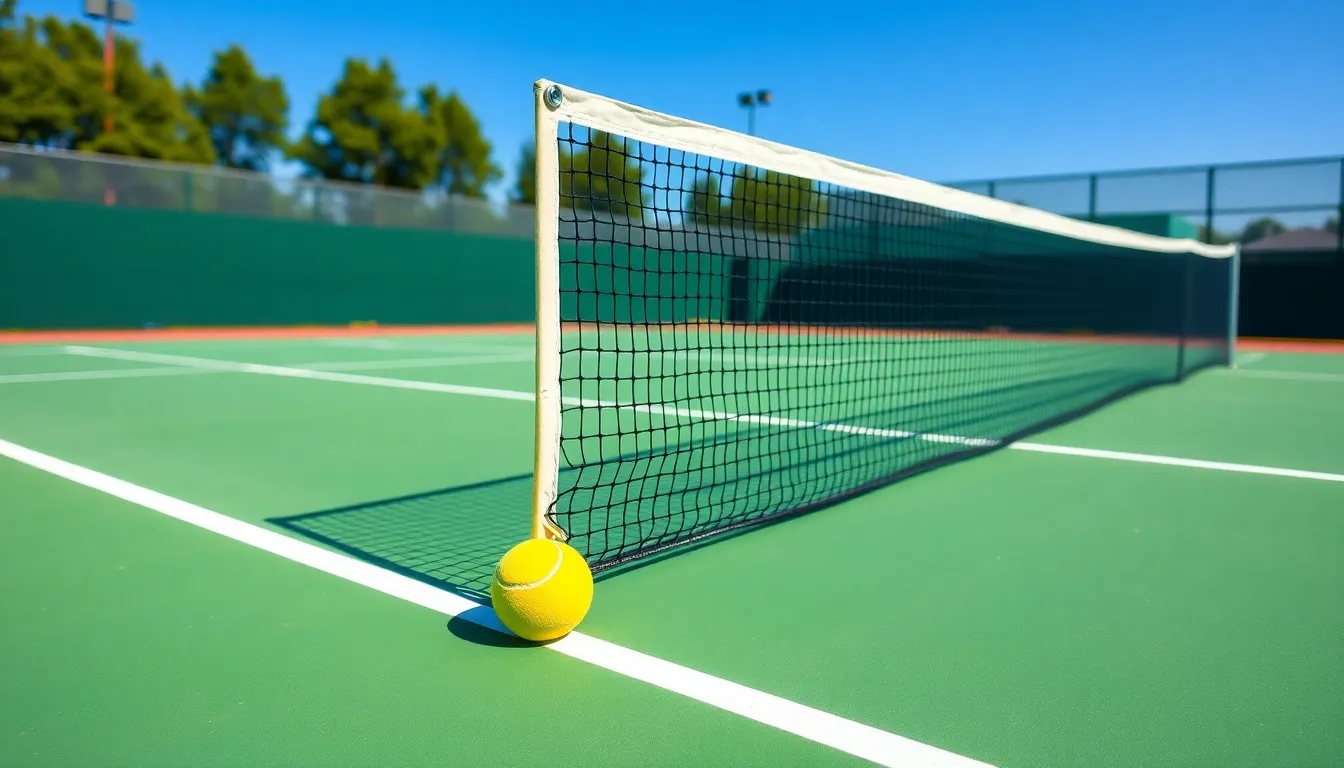Wondering how high a tennis net is? This seemingly simple question is actually crucial for proper gameplay, whether you’re setting up a court in your backyard or trying to understand the official regulations of the sport.
The height of a tennis net directly impacts how you’ll play the game and can even affect your strategy. While professional players have these measurements memorized, recreational players often overlook this important detail. Understanding the standard height requirements ensures you’re playing by the rules and developing proper techniques that will translate to any court you step on.
Standard Tennis Net Height Requirements
Tennis nets maintain a precise, standardized height across official competitions worldwide. These measurements ensure fair play and consistent playing conditions for all participants, whether in recreational games or professional tournaments.
Official Measurements for Singles and Doubles Play
The official tennis net height measures exactly 3 feet (0.914 meters) at the center for both singles and doubles matches. At the net posts, the height increases slightly to 3 feet 6 inches (1.07 meters). This height difference creates a slight dip in the middle of the net, which has become a defining characteristic of tennis court setup.
The International Tennis Federation (ITF) strictly enforces these measurements during professional tournaments. For Olympic competitions, Grand Slams, and ATP/WTA events, officials verify net heights before each match begins. During my years coaching college players, I’ve noticed how this slight center dip becomes a strategic element that experienced players incorporate into their shot selection.
For doubles play, the court width expands to 36 feet (10.97 meters) compared to the 27 feet (8.23 meters) used in singles matches. Even though this width difference, the net height requirements remain identical between both formats.
Center Strap Requirements
The center strap serves as an essential component of proper tennis net setup. This white band attaches to the middle of the net and anchors to the court surface, maintaining the required 3-foot (0.914-meter) height at center court. Without this strap, the net naturally rises in the middle, creating irregular playing conditions.
Center straps must pull the net down to exactly 3 feet at midpoint, no more and no less. Tournament officials frequently check this measurement with specialized height gauges throughout competitions. The strap itself typically measures between 1.5-2 inches wide and connects to an anchor embedded in the court surface.
During my coaching sessions at local clubs, I’ve found many recreational courts with improperly adjusted center straps, sometimes off by several inches. This seemingly minor detail can significantly impact play, especially for shots that barely clear the net. Players who practice on properly regulated nets develop more accurate muscle memory for shots like drop volleys and passing shots that depend on precise net clearance.
Tennis Net Height Variations

Tennis net heights vary depending on the level of play and age of participants. These variations accommodate different playing conditions while maintaining the integrity of the game across various competitive environments.
Professional vs. Recreational Standards
Professional tennis adheres strictly to the International Tennis Federation’s height specifications of exactly 3 feet (0.914 meters) at the center and 3.5 feet (1.07 meters) at the posts. Grand Slam tournaments like Wimbledon and the US Open maintain these measurements with precision to ensure fair competition at the highest level. Recreational courts generally follow these same standards, though maintenance may be less rigorous. During my coaching sessions at local clubs, I’ve noticed many recreational nets aren’t checked as frequently, sometimes resulting in slight height discrepancies that can affect players’ training consistency. A properly maintained net helps recreational players develop skills that translate seamlessly to tournament play.
Junior Tennis Net Height Modifications
Junior tennis programs adjust net heights to accommodate younger players’ physical development and skill acquisition. For children 8 years and under, nets are typically set at approximately 2 feet 9 inches (82 cm) to allow successful rallies and proper technique development. These modified heights create a more proportionate playing experience relative to a child’s stature. In my experience coaching junior players, these adaptations significantly improve engagement and confidence. One of my young students, Emma, struggled with standard-height nets but flourished when we switched to age-appropriate equipment, eventually developing a powerful serve that now challenges even adult players. As junior players advance in age and ability, net heights gradually increase until they reach the standard 3-foot (0.914 meter) measurement used in professional play.
How to Properly Measure a Tennis Net

Measuring a tennis net correctly ensures fair play and compliance with official regulations. Precise measurements help maintain the standard 3-foot (0.914 meters) height at the center and 3.5-foot (1.07 meters) height at the net posts, creating optimal playing conditions for all participants.
Tools Needed for Accurate Measurement
Accurate tennis net measurement requires exact tools to ensure precision. A retractable tape measure with clear feet and meter markings serves as your primary measurement device, allowing you to check both metric and imperial measurements with ease. A small spirit level helps maintain vertical alignment during measurement, particularly on courts with slight slopes or uneven surfaces. Consider keeping a pencil or chalk marker handy to note consistent measurement points across different sections of the net, especially if you’re checking multiple courts or documenting changes over time.
Step-by-Step Measurement Process
The measurement process begins with positioning yourself directly at the center of the court facing the net. Align your tape measure vertically against the center strap of the net, ensuring it’s perpendicular to the ground for an accurate reading. Extend the tape measure from the court surface to the top edge of the net, reading the measurement at exactly 3 feet (0.914 meters) for a regulation net. Use your spirit level to verify the tape measure remains perfectly vertical during measurement, as even slight angles can produce inaccurate results.
Repeat measurements at multiple points along the net, including at both posts where the height should read 3.5 feet (1.07 meters) and several points in between to check for proper tension. Adjust the net tension if measurements deviate from the standard, typically by tightening or loosening the center strap for center height adjustments or using the net winding mechanism at the posts for overall tension. Document your measurements if you’re responsible for maintaining multiple courts, creating a consistent record that helps identify when adjustments become necessary.
Common Tennis Net Height Issues and Fixes

Tennis nets require proper maintenance to ensure fair play and optimal performance. Even minor deviations from the standard 3-foot center height can significantly impact how the game unfolds and potentially give one player an unfair advantage.
Dealing with Net Sag
Net sag occurs when the center of the tennis net drops below the regulation 3-foot (0.914 meters) height. This common issue develops gradually as the net materials stretch from continuous tension and exposure to weather elements. Players often notice sag when balls clear the net more easily in the middle than at the sides, creating inconsistent playing conditions.
Regular inspection prevents this problem from affecting your game. Check your net’s center height monthly during active seasons using a measuring tape from the ground to the net’s top edge. Courts with heavy usage benefit from weekly checks to maintain proper height standards.
The center strap plays a crucial role in preventing sag. This adjustable band connects the net’s middle section to the court surface, maintaining the regulation 3-foot height. If your center strap is loose or damaged, the net will inevitably sag, affecting shot trajectory and game fairness.
Adjusting Net Tension
Proper net tension balances firmness with appropriate give when balls contact the net. A correctly tensioned net feels taut but has slight flexibility when pressed gently. Tennis courts feature a cable running through the net’s top band that connects to tensioning mechanisms on both posts.
To adjust tension on most courts, locate the winding crank or lever system on one of the net posts. Turn the mechanism clockwise to increase tension (eliminating sag) or counterclockwise to decrease tension if the net appears overly tight. Make small adjustments—quarter turns at a time—then walk to the center to check the results before continuing.
For center strap adjustments, find the buckle or clasp where the strap meets the court surface. Shortening the strap raises the net’s center point, while lengthening it lowers the height. Always measure after adjusting to confirm the center height matches the official 3-foot standard.
Seasonal temperature changes affect net tension, with nets often becoming looser in hot weather and tighter in cold conditions. Professional groundskeepers adjust tension accordingly throughout the year, and recreational players should follow this practice for consistent playing conditions.
Tennis facilities with multiple courts should document tension settings that work well, creating a reference guide for maintenance staff. This practice ensures uniformity across all courts and helps maintain proper playing conditions regardless of which court you choose.
Impact of Net Height on Gameplay

Tennis net height significantly influences playing strategies and shot selection during matches. The standard height requirements create a balanced gameplay environment that challenges players while rewarding technical skill.
How Proper Net Height Affects Different Playing Styles
The regulation tennis net height creates distinct advantages for various playing styles across the court. Baseline players typically benefit from the higher sides (3.5 feet/1.07 meters at the posts), as this configuration rewards their consistent groundstrokes with high clearance margins. During my coaching sessions, I’ve noticed baseline specialists often develop a natural rhythm that accounts for this height differential when executing deep, penetrating shots.
Serve-and-volley players leverage the lower center height (3 feet/0.914 meters) to their advantage. This reduced height at the net’s middle section makes aggressive net approaches more effective, particularly when executing angled volleys and cross-court shots. One of my semi-professional students improved his net game dramatically after we focused specifically on targeting the net’s center during approach shots.
The strategic implications of net height extend to shot selection decisions throughout matches. Cross-court shots are generally safer and more common due to the net’s lower center, creating longer rallies and more consistent point construction. Down-the-line shots, while riskier because they must clear the higher sides of the net, offer greater rewards when executed properly by reducing the opponent’s reaction time.
Shot trajectories are directly influenced by these height variations. Players must adjust their stroke production based on whether they’re hitting toward the center or sides of the court. This adjustment becomes automatic for experienced players but requires conscious technique modification for beginners and intermediates.
Net height also impacts serving strategies across different playing surfaces. On faster courts like grass, the standard net height complements aggressive first serves, while on slower clay courts, players often use the net height to their advantage by incorporating more spin to clear the net with greater margin.
The carefully balanced net height of 3 feet center/3.5 feet sides creates an equilibrium between offensive and defensive play. A net set too low would excessively favor aggressive net rushers, while a uniformly higher net would skew advantages toward conservative baseline play. This standardized measurement ensures tennis remains a ever-changing sport that rewards various playing styles and strategic approaches.
Conclusion
Understanding tennis net height is more than just following rules—it’s about optimizing your game. Whether you’re playing at 3 feet in the center on a professional court or adjusting to 2 feet 9 inches for junior players you’re participating in a carefully designed system that balances offensive and defensive play.
Regular measurement and maintenance of your tennis net ensures fair competition and consistent training conditions. The standard height creates the perfect environment where both baseline players and serve-and-volley specialists can thrive.
Next time you step onto the court take a moment to appreciate how this seemingly simple specification shapes every aspect of the game you love. The perfect tennis net height isn’t just a measurement—it’s the foundation of tennis as we know it.
Frequently Asked Questions
What is the standard height of a tennis net?
The standard height of a tennis net is 3 feet (0.914 meters) at the center for both singles and doubles matches. At the net posts, the height increases to 3 feet 6 inches (1.07 meters). This dip in the middle is intentional and strictly enforced by the International Tennis Federation (ITF) during professional tournaments.
Why is the correct tennis net height important?
Correct net height ensures fair play, consistent training, and proper technique development. Playing on courts with varying net heights can affect muscle memory and performance. For competitive players, practicing on regulation-height nets is essential for tournament preparation. Standard heights also create the balanced gameplay that makes tennis challenging and rewarding.
How does net height differ for junior players?
Junior tennis programs modify net heights for younger players to help their development. For children 8 years and under, nets are typically set at approximately 2 feet 9 inches (82 cm). These lower heights allow young players to develop proper technique and build confidence before transitioning to standard heights as they advance in age and skill level.
What tools do I need to measure a tennis net correctly?
To measure a tennis net accurately, you’ll need a retractable tape measure, a spirit level (for checking horizontal alignment), and possibly a small step ladder to reach the top of the net. Some players also use specialized net measuring tools that combine these functions for quick and accurate measurements.
How do I fix a sagging tennis net?
To fix a sagging net, adjust the center strap that anchors the middle of the net to the court surface. Tighten the strap until the center height measures exactly 3 feet (0.914 meters). For older nets with significant sag, check the tension mechanism on the net posts and increase tension as needed. Regular inspections can prevent excessive sagging.
How does net height affect gameplay strategies?
Net height significantly influences playing strategies and shot selection. Baseline players benefit from the higher sides that require clearing the net with topspin. Serve-and-volley players leverage the lower center height for aggressive net approaches. Cross-court shots are safer due to the lower center point, while down-the-line shots offer greater rewards but carry more risk.
Does tennis net height vary on different court surfaces?
The official net height remains consistent across all court surfaces. However, how players approach the net may change based on surface. On faster courts like grass, the lower center height facilitates serve-and-volley tactics. On slower clay courts, the standard height helps maintain balance between offensive and defensive play despite the different ball bounce characteristics.
How often should tennis nets be checked for proper height?
Tennis nets should be checked at least once weekly for recreational courts and daily for tournament play. Weather conditions, especially temperature fluctuations and humidity, can affect tension and cause the height to change. Before competitive matches, checking and adjusting net height is essential to ensure fair play conditions.


